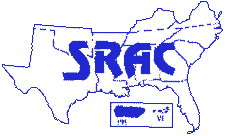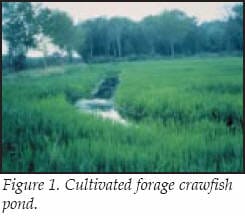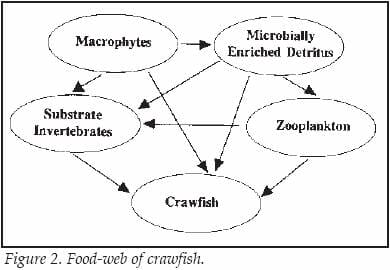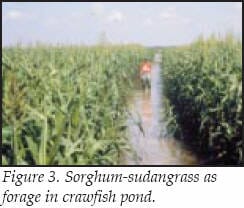 Crawfish
production can be integrated
with agricultural crop rotations,
and the crawfish life cycle can be
easily manipulated to fit a variety
of cultural situations. Crawfish
aquaculture relies on control of
pond hydrology to simulate optimal
wet and dry conditions occurring
in natural riverine and wetland
habitats. Crawfish grow and
mature during the wet or flooded
cycle and survive the dry periods
by digging burrows. Crawfish
ponds are filled in the fall to coincide
with peak spawning of
females in burrows. When burrows
are filled with water, adults
and juveniles leave the burrow
and distribute themselves
throughout the pond.
Crawfish
production can be integrated
with agricultural crop rotations,
and the crawfish life cycle can be
easily manipulated to fit a variety
of cultural situations. Crawfish
aquaculture relies on control of
pond hydrology to simulate optimal
wet and dry conditions occurring
in natural riverine and wetland
habitats. Crawfish grow and
mature during the wet or flooded
cycle and survive the dry periods
by digging burrows. Crawfish
ponds are filled in the fall to coincide
with peak spawning of
females in burrows. When burrows
are filled with water, adults
and juveniles leave the burrow
and distribute themselves
throughout the pond.
Crawfish production systems
Crawfish ponds can be singlecrop and rotational. Single-crop ponds are in the same location every year with a continuous management scheme. Rotational ponds are those in which crawfish are rotated with other crops. Rotational production also can mean rotating the physical location of the field in which crawfish are grown.
Single-crop ponds
Single-crop ponds are constructed and managed solely for the purpose of culturing crawfish. Crawfish can be harvested in single- crop ponds 1 to 2 months longer than in some rotational systems because there is no overlap with planting, draining, and harvesting schedules of other crops. The three principal types of ponds are cultivated forage ponds, naturally vegetated ponds, and wooded ponds. The following crawfish culture cycle is applicable to each of the three types:
- April - May: Stock 50 to 60 pounds of adult crawfish per acre (new ponds only).
- May - June: Drain pond over a 2- to 4-week period.
- June - August: Plant crawfish forage or manage natural vegetation.
- October: Reflood pond (based on air temperature).
- November - May/June: Harvest crawfish.
- May/June: Drain pond and repeat cycle without restocking crawfish.
 Cultivated Forage Pond. These
are permanent ponds where a cultivated
forage crop is established
annually (Fig. 1). Ponds are usually
tillable to facilitate planting and
management of rice or other agronomic
crops. Ponds are often
designed with baffle levees and
recirculation systems to improve
production. Because they are
intensively managed, cultivated
forage ponds generally have the
highest yields (pounds of crawfish)
per acre.
Cultivated Forage Pond. These
are permanent ponds where a cultivated
forage crop is established
annually (Fig. 1). Ponds are usually
tillable to facilitate planting and
management of rice or other agronomic
crops. Ponds are often
designed with baffle levees and
recirculation systems to improve
production. Because they are
intensively managed, cultivated
forage ponds generally have the
highest yields (pounds of crawfish)
per acre.
Naturally Vegetated Ponds. These
are marsh impoundments and
agricultural lands managed to
encourage the growth of naturally
occurring vegetation. Marsh
ponds are typically constructed in
wetland areas with large amounts
of organic matter in the soil,
which may lower water quality
and decrease crawfish production.
Although these ponds may be
managed exclusively for crawfish,
they are generally not recommended
for commercial crawfish
production because yields are
inconsistent.
Agricultural lands unsuited for
growing grain crops because of
poor drainage or soils are sometimes
used for naturally vegetated
crawfish ponds. It can be
difficult to establish an adequate
forage base with the proper balance
of aquatic and terrestrial
plant species. Water management
also can be a problem. However,
these kinds of ponds can sometimes
be effective low-input production
systems.
Wooded Ponds. These ponds are
built on heavy clay soils in forested
(cypress-tupelo swamps)
areas near drainage canals. Water
temperatures tend to be lower
because of shading. Wooded
ponds have poor stands of vegetative
forage; leaf litter provides
the bulk of forage. However,
rapid leaf fall can cause water
quality to deteriorate because
oxygen may become depleted as
leaves decay. Trees hinder water
movement and obstruct access by
harvesting boats, so they are
sometimes removed. More
intense water management is
needed to maintain good water
quality in wooded impoundments.
Wooded ponds usually produce
fewer pounds of crawfish per
acre than other production systems,
but large crawfish may be
produced at a profit. After several
years of alternate flooding and
drying, wooded ponds lose many
hardwood trees. A natural vegetation
base of terrestrial grasses
and aquatic plants subsequently
develops, which improves crawfish
habitat. There are some positive
aspects of wooded ponds,
including the potential for waterfowl
hunting, the low initial
start-up costs, and the ability to
selectivly remove unwanted
vegetation.
Rotational ponds
The most common rotational
pond systems are rice-crawfishrice,
rice-crawfish-soybeans, and
rice-crawfish-fallow. In the ricecrawfish-
rice crop rotation, both
rice and crawfish crops are harvested
annually. This is commonly
referred to as double cropping. In
the rice-crawfish-soybeans rotation,
farmers produce three different
crops in 2 years. In the ricecrawfish-
fallow rotation, farmers
leave the field fallow between
rotations to control weeds and
prevent crawfish overpopulation.
In this system, crawfish are produced
in different physical locations
from year to year.
Well managed crawfish rotation
systems use farm resources efficiently,
diversify production, and
add income for many farm families.
However, maximum production
from each crop usually is not
achievable. Some management
compromise is necessary from one
or all crops.
Rice-Crawfish-Rice. Rice fields
are the most readily adaptable
areas for crawfish culture. The rice
farmer can use the same land,
equipment, pumps and farm labor
that are already in place. After the
grain is harvested, the remaining
stubble is fertilized, flooded and
allowed to re-grow. This ratoon
crop is the forage base for crawfish
production. Maximum crawfish
production is sometimes compromised
because rice culture
takes precedence over crawfish
production. For example, rice production
often requires the use of
pesticides and different water
management than is optimal for
crawfish. These ponds are usually
drained in early spring (March 1
to April 1) so that rice can be
replanted. This shortens the crawfish
harvest season 1 to 2 months
and reduces potential crawfish
yield. A typical time-table is as follows:
- March - April: Plant rice.
- June: At permanent flood (rice 8 to 10 inches high), stock 40 to 50 pounds of adult crawfish per acre.
- August: Drain field and harvest rice.
- October: Re-flood rice field.
- December - April: Harvest crawfish.
- March - April: Drain pond and replant rice (restocking of crawfish may or may not be necessary).
- March - April: Plant rice.
- June: Stock 40 to 50 pounds of adult crawfish per acre at permanent flood.
- August: Drain field and harvest rice.
- October: Re-flood rice field.
- December - May: Harvest crawfish.
- Late May - June: Drain pond and plant soybeans.
- October - November: Harvest soybeans.
- November - March: Re-flood pond and harvest crawfish (or leave field fallow).
- March - April: Plant rice (restocking of crawfish is probably necessary).
- March - April: Plant rice.
- June: Stock 40 to 50 pounds of adult crawfish per acre at permanent flood.
- August: Drain pond and harvest rice.
- October: Re-flood rice field.
- December - June/July: Harvest crawfish.
- July: Drain pond.
- August - March: Fallow.
- March - April: Plant rice.
Forages
In a natural ecosystem, crawfish
eat a variety of plants and animals.
Crawfish prefer aquatic
invertebrates but will feed on
detritus and growing vegetation.
Detritus, or decomposing organic
material, is the base of the complex,
self-sustaining food system
required in crawfish culture
(Fig. 2).

As organic matter decomposes, it
becomes "coated" with bacteria,
other microorganisms, and small
invertebrates that increase its
nutritional quality. Larger aquatic
fauna such as insects, worms,
clams, snails and zooplankton
feed on the enriched decomposing
vegetation. It is these animals that
make up the major part of the
crawfish diet. Crawfish eat very
little living plant material, but rely
on the small invertebrates that
live on or near plant stems. Some
plant seeds may also be important
food resources.
Crawfish production can use
planted and cultivated forage
crops or voluntary natural vegetation.
The forage must provide
detritus to the underwater foodweb
consistently throughout the
growing season. Many aquatic
plants, such as alligatorweed
(Alternathera philoxeroides), perform
this task poorly but can provide
substrate and cover for other
organisms that are food for crawfish.
Cultivated crops are more
consistent from year to year and
usually provide for a more consistent
supply to the underwater
food-web.
Cultivated forages
Cultivated forages provide a controlled,
consistent supply of detritus
that results in good crawfish
yields. Planting an agronomic
crop allows farmers to control the
type and amount of available forage.
Forage density is more predictable
with an agronomic crop
because cultural practices are well
established. Research has shown
that potential crawfish yield can
be increased 2- to
3-fold with good
stands of cultivated
forage as compared
to using
natural vegetation
only.
Rice (Oryza sativa)
is the preferred
forage for crawfish.
Rice is less
detrimental to
water quality than
terrestrial plants.
It can be planted
for grain production,
with the
post-harvest residue and regrowth
serving as crawfish forage,
or it can be planted solely as a
crawfish forage with no intent to
produce grain.
When selecting a rice variety for
crawfish production consider the
culture system (rotational or single
cropping), forage biomass production,
lodging characteristics,
disease resistance, adaptability to
local environmental conditions,
and rice ratoon potential. Check
with your county Extension agent
for a list of recommended rice
varieties to use solely as planted
forages.
Rice for Grain and Forage.
Proper variety selection and cultivation
practices will ensure optimum
grain yield, but several
other considerations are important
when crawfish production is to
follow. Timing of the grain harvest
is determined by the time of
planting, the variety, and the
weather; it will also affect subsequent
forage production. For best
results, the ratoon crop should
reach maximum forage production
after the harvest but should
not reach full maturity. Ratoon
crops that do reach full maturity
wither (senesce) and often become
prematurely depleted, causing
forage shortages.
Huge amounts of loose plant
stalks and leaves remain in the
field after grain harvest. This
residue should be reduced before
the field is re-flooded or it will
cause water quality to deteriorate.
A straw chopper on the rice combine
will chop up the excess straw
into smaller pieces that decompose
more rapidly during the
weeks before re-flooding. Or, the
harvest residue can be bailed or
burned.
Dead plant material can not be
effectively stockpiled in a pond.
The only way to increase longterm
supply is to encourage
regrowth of rice stubble after the
grain has been harvested. A light
application of nitrogen (20 to 40
pounds of nitrogen per acre) can
be applied shortly after harvest.
The field should then be flushed if
adequate moisture is not available.
Timely flushing of the field
will prevent the loss of nitrogen
and encourage rapid stubble
regrowth.
Rice for Forage. It is often desirable
to grow a stand of rice as forage
only. The variety chosen
should produce high vegetative
biomass, be resistant to lodging
and disease, senesce slowly, and
persist throughout the crawfish
production season. Forage rice
should be planted early enough to
allow maximum vegetative
growth without reaching full
maturity. Flooding immature rice
results in better water quality
because there is less decomposing
organic matter at the time of fall
flooding. Rice that does not reach
full maturity persists longer under
flooded conditions and is more
likely to generate additional
growth in the spring.
The potential and requirements
for rice production to be adequate
for crawfish culture vary from
area to area. Follow the recommended
practices for your region.
In general, rice is either drilled or
broadcast planted in well-tilled
seedbeds at rates ranging from 90
to 120 pounds per acre. Although
rice requires considerable water
for growth, commercial rice producers
maintain a shallow flood
mainly for weed control and better
fertilizer management. This is
not necessary when growing rice
for crawfish forage; in fact, standing
water on the seed or seedling,
if it is too hot, can result in poor
stands. Rice may be irrigated during
dry periods. Fertilizer usually
is required for good rice growth
and development; soil should be
tested first to determine its fertility.
A common application rate is
60 to 80 pounds per acre of nitrogen
(N) and 30 pounds per acre of
both phosphorus (P) and potassium
(K). Herbicides are not necessary.
Some weed invasion is not
harmful (and may even be desirable)
in crawfish crops. Consult
knowledgeable professionals for
assistance.
Sorghum-sudangrass. Good rice
stands may be difficult to achieve
in some geographical regions and
under some environmental conditions,
especially during late summer
in the southern U.S. Other
forage crops, such as sorghumsudangrass
hybrid (Sorghum bicol-
or), may be a good alternative for
crawfish forage (Fig. 3).
 Sorghum-sudangrass seed is
available from most farm suppliers
and seed dealers. It grows
rapidly, produces larger quantities
of vegetative matter than rice, is
drought resistant, and may be
more reliable than rice for late
summer stand establishment.
Sorghum-sudangrass tends to
persist longer than rice in flooded
crawfish ponds, which makes
more forage available during the
latter part of the crawfish growing
season.
Sorghum-sudangrass seed is
available from most farm suppliers
and seed dealers. It grows
rapidly, produces larger quantities
of vegetative matter than rice, is
drought resistant, and may be
more reliable than rice for late
summer stand establishment.
Sorghum-sudangrass tends to
persist longer than rice in flooded
crawfish ponds, which makes
more forage available during the
latter part of the crawfish growing
season.
Sorghum-sudangrass should be
used only in ponds where a forage
is planted in late summer.
Target planting dates should be
early August through early
September in the deep South.
If planted too early, sorghumsudangrass
is likely to mature
before flood-up, which can be
detrimental to water quality when
plants lodge or large numbers of
leaves sluff off into the water.
However, planting should not be
postponed too long because cooler
weather and the shorter days of
early fall may inhibit plant establishment
and growth. Advanced
stands of sorghum-sudangrass
should be cut to a 1- to 2-inch
stubble in early to mid-August
and baled.
Sorghum-sudangrass seed can be
drilled or broadcast onto moist
soil. Drilling is preferred and is
less risky. Seeding rates should be
20 to 25 pounds per acre for
drilling and 25 to 30 pounds per
acre for broadcasting. Optimum
germination temperature is 70 to
85 degrees F. Seeds need adequate
soil moisture to germinate, but the
seedlings are fairly drought tolerant
once they are established.
Sorghum hybrids are sensitive to
very low soil pH but seem to tolerate
a pH as low as 5.5 without
problems. Fertilizers can significantly
increase growth and the
vegetative biomass of sorghumsudangrass.
Follow the
Cooperative Extension Service
fertilizer and culture recommendations
for sorghum-sudangrass
in your area.
It may be desirable to mow trapping
lanes in the pond just before
flooding in the fall, especially if
sorghum-sudangrass was planted
early. Tall plants restrict vision
from a boat during early-season
harvest.
Pesticide toxicity
Be careful using pesticides in or near crawfish ponds; crawfish are very sensitive to most chemicals and carelessness can quickly eliminate production. Read the label of any chemical or compound before using it.
Natural vegetation
Natural voluntary vegetation is
usually the least expensive to
establish and can sometimes be
satisfactory as a forage crop; however,
it is often unreliable and
insufficient for maximum crawfish
production. When flooded,
voluntary terrestrial grasses and
sedges usually decompose rapidly.
This reduces water quality and
provides short-lived detrital
sources. Aquatic and semi-aquatic
plants such as alligatorweed
(Alternathera philoxeroides) and
smartweed (Polygonium spp.) are
superior to terrestrial grasses
because they continue to live
when flooded. During much of
the season little material is cast
from these plants to form detritus.
However, during the winter the
emergent parts of the plants die
and form large amounts of detritus,
usually at a time when low
water temperatures reduce feeding
by aquatic organisms.
The three major disadvantages
of using natural vegetation are:
(1) stand density varies with location
and time of year, and is
unpredictable from one year to
the next; (2) cultural practices for
natural plant species are not well
understood; and (3) many natural
plants are considered noxious
weeds and are unwanted where
agronomic crops will be grown in
subsequent years. Despite these
obstacles, ponds with an appropriate
mixture of aquatic, semiaquatic
and terrestrial vegetation
do occasionally produce good
crawfish crops.
Forage production is one of the
most important components of
crawfish production. This publiction
has outlined the basics of forage
based production systems for
crawfish in the Southeast. For
more information on crawfish
production contact the Extension
Fisheries/Aquaculture Specialist
in your state.
Source: Southern Regional Agricultural Center and the Texas Aquaculture Extension Service - October 2004

